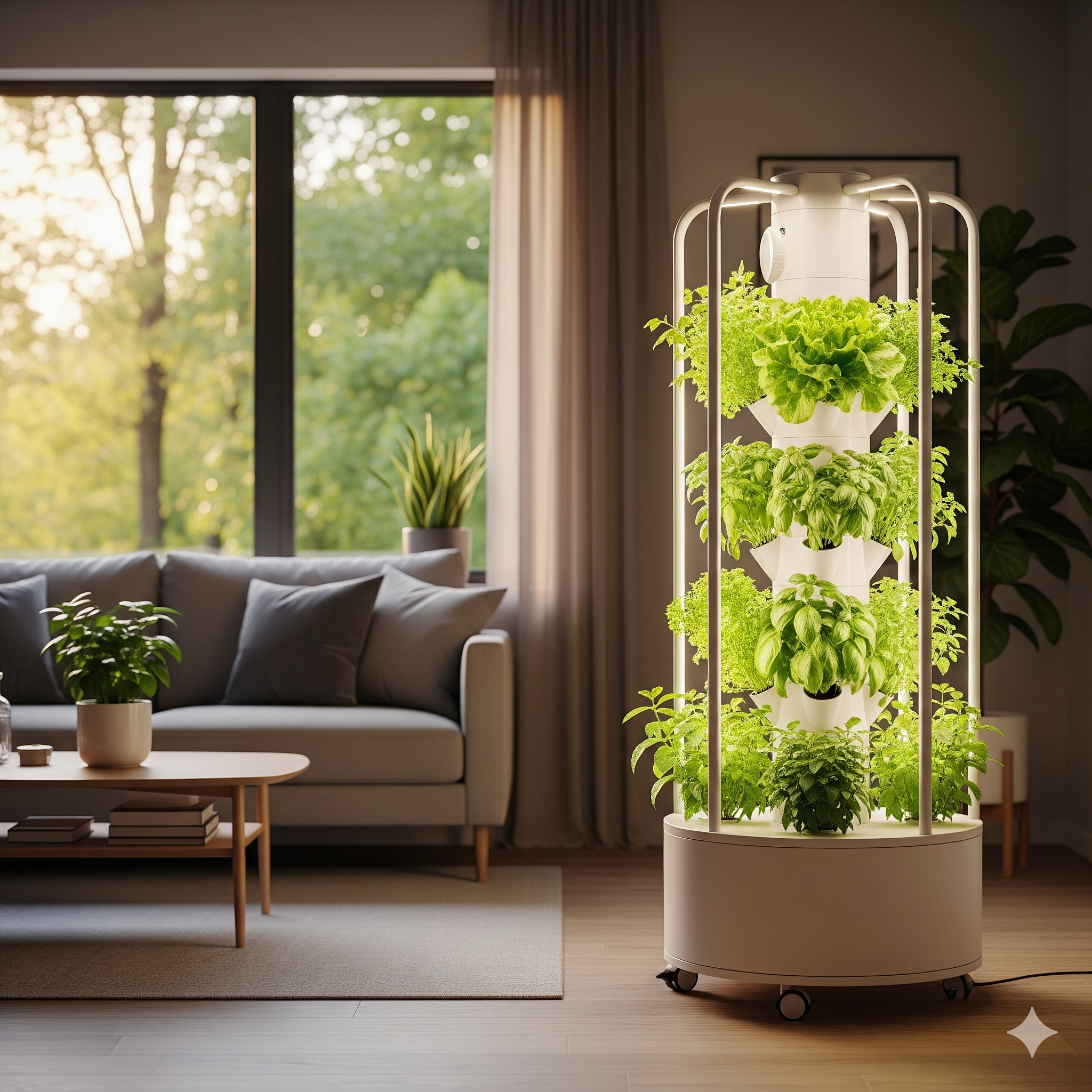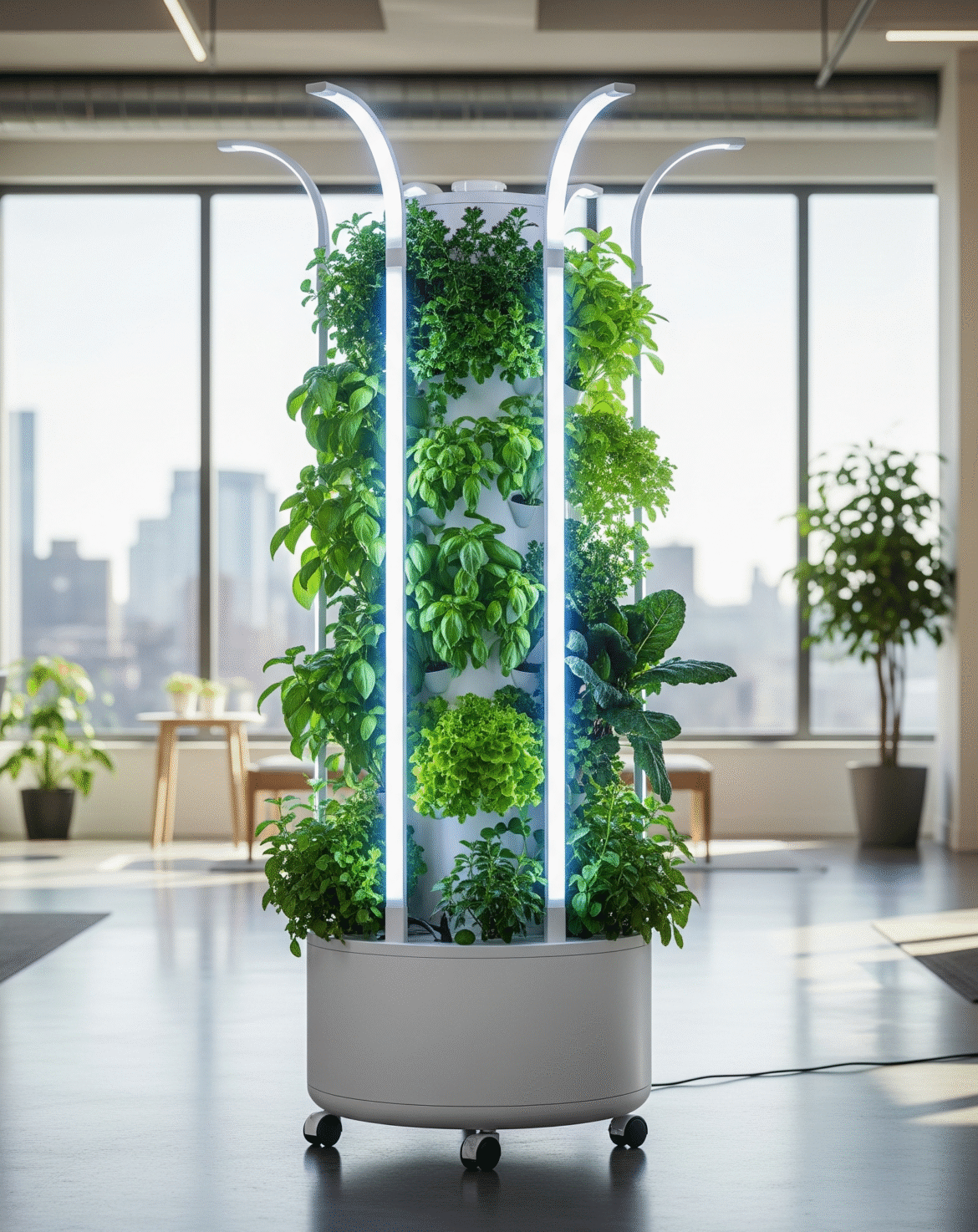Have you ever wanted to grow your own fresh vegetables and herbs but felt limited by space? Traditional gardening, while rewarding, often requires a significant amount of land, not to mention a lot of water and effort. But what if there was a better way? Enter the aeroponic tower garden, a revolutionary vertical growing system that’s changing the way we think about cultivating food. By suspending plants in the air and feeding their roots a nutrient-rich mist, this cutting-edge technology allows you to grow more in less space, with less water, and in a shorter amount of time.
What Is an Aeroponic Tower and How Does It Work?
At its core, an aeroponic tower is a vertical, soil-free gardening system. It’s a type of hydroponics, but with a key difference: instead of submerging roots in water, they are left to hang in a humid, oxygen-rich environment. This is the secret to their incredible efficiency.
The basic mechanism is surprisingly simple. At the base of the tower, a reservoir holds a solution of water and essential plant nutrients. A submersible pump, located inside this reservoir, pushes the nutrient-rich water up through a central pipe to the very top of the tower. From there, the solution cascades back down, dripping onto the roots of each plant along the way. This creates a cyclical, closed-loop system where water is constantly being recycled and reused, resulting in an incredible water savings of up to 95% compared to conventional soil gardening.
The magic happens in the brief moments between watering cycles. Because the roots are suspended in the air, they have constant access to oxygen. This is a crucial factor for plant health and growth. In soil, roots can sometimes become waterlogged and starved of oxygen, a condition that can lead to root rot. With aeroponics, this problem is virtually eliminated, allowing plants to “breathe” more efficiently and absorb nutrients with greater ease.
Aeroponics vs. Hydroponics: The Key Distinction
Many people confuse aeroponics with hydroponics, and for good reason. Aeroponics is actually a subcategory of hydroponics. Think of hydroponics as the family and aeroponics as one of its distinct members.
- Hydroponics is the broad term for growing plants without soil, using a nutrient-rich water solution. Methods like deep water culture, ebb and flow, and nutrient film technique all fall under this umbrella. With these methods, plant roots are either fully or partially submerged in water.
- Aeroponics, on the other hand, is a more advanced technique. Its defining feature is the suspension of plant roots in an air chamber, where they are fed with a fine mist or spray of nutrient solution at regular intervals. This intermittent feeding schedule allows the roots to get the best of both worlds: they receive the nutrients they need while also having constant access to the oxygen they crave.
This distinction is what gives aeroponic systems their edge in terms of speed and efficiency. The enhanced oxygen uptake leads to faster, healthier plant growth. Studies have shown that plants grown aeroponically can mature up to three times faster than those grown in soil, and often produce higher yields.
The Benefits of Using an Aeroponic Tower
The advantages of a vertical aeroponic tower garden go far beyond just saving space. These systems are a game-changer for both urban dwellers and large-scale agricultural operations.
- Faster Growth and Higher Yields: The combination of an oxygen-rich environment and direct nutrient delivery supercharges plant growth. Your plants will develop more quickly and produce a greater harvest. This is especially beneficial for fast-growing crops like leafy greens and herbs, allowing you to enjoy a continuous supply of fresh produce.
- Exceptional Water Efficiency: Water is a precious resource, and traditional farming methods can be incredibly wasteful. With a closed-loop aeroponic system, water is recycled over and over again, using up to 95% less water than growing in the ground. This makes them a perfect solution for arid regions or anyone looking to reduce their environmental footprint.
- No Soil, No Mess: For anyone who has ever dealt with muddy hands or insects in their indoor garden, the lack of soil is a major perk. Aeroponic systems are clean, making them ideal for indoor use, whether in an apartment, a kitchen, or a basement. This also means you don’t have to worry about soil-borne pests or diseases.
- Space-Saving Design: This is perhaps the most immediate benefit for many people. By growing vertically, an aeroponic tower can cultivate dozens of plants in just a few square feet of floor space. A single tower can hold as many as 24 plants, which would normally require several square meters of land. This makes them perfect for balconies, patios, and small homes.
- Precise Nutrient Control: With an aeroponic system, you have complete control over what your plants consume. You can easily adjust the nutrient mix to suit the specific needs of different plants, ensuring they get exactly what they need to thrive.

Setting Up and Maintaining Your Tower
Getting started with an aeroponic system is easier than you might think. Most commercial towers are designed for a “plug and play” experience.
- Assembly: The tower sections typically stack on top of each other. You’ll simply need to place your seedlings or cuttings into the net pots in the designated growing ports.
- Reservoir: Fill the base reservoir with water and add a nutrient solution according to the manufacturer’s instructions.
- Timers: Set the timers for both the water pump and the grow lights. The beauty of these systems is their automation; once you set the schedule, you can essentially “set it and forget it.” A common watering schedule to start with is 15 minutes on and 45 minutes off.
Maintaining the system requires a few simple, regular checks. You’ll need to monitor the water level in the reservoir and add more as needed. It’s also crucial to check the pH of the nutrient solution weekly to ensure your plants can properly absorb nutrients. The ideal pH range for most plants is between 5.5 and 6.5. With minimal effort, you can ensure your plants are always in optimal growing conditions.
Best Plants to Grow in an Aeroponic Tower
The versatility of aeroponic towers means you can grow a wide variety of crops. Leafy greens like lettuce, kale, spinach, and Swiss chard are excellent choices because they grow quickly and don’t require much support. Herbs such as basil, mint, parsley, and cilantro also thrive in these systems.
You can also grow fruiting plants like strawberries, tomatoes, and cucumbers. However, because these are vining plants, they will require some form of support, such as a trellis, to manage their weight and keep them from toppling over. With the right setup, an aeroponic tower can provide you with a diverse and bountiful harvest all year long.
Conclusion
The aeroponic tower is more than just a gardening tool; it’s a symbol of a sustainable and efficient future. By harnessing the power of water, air, and technology, these vertical systems allow us to cultivate food in new ways, overcoming the traditional barriers of space and resources. Whether you live in a city apartment or simply want a more efficient way to garden at home, the aeroponic tower garden offers a practical and rewarding solution.
If you’re ready to start your journey into the world of soil-free gardening, consider exploring the possibilities with ALTO Garden. Their innovative systems are designed to make it easy for anyone to experience the joy of growing their own food, no matter where they live.


